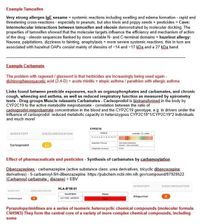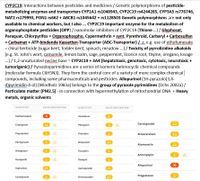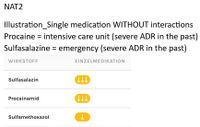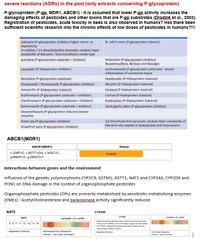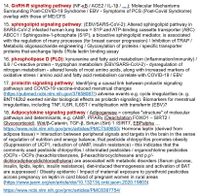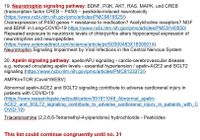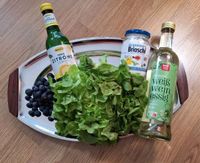Multiple Chemical Sensitivity (MCS) - ME/CFS - EBV - Long Covid
„The Great Resignation“- Inclusion, diversity and equality
“The Great Resignation” – Inclusion, Diversity, and Equality in the Context of MCS, CFS, and Long COVID
Labor Shortages and Untapped Potential
In an era of severe labor shortages, companies often struggle to find qualified and motivated professionals. However, have they truly explored all available talent pools? The global phenomenon of “The Great Resignation” demonstrated that workers increasingly prioritize workplace conditions, health protections, and individualized needs.
One critical aspect remains largely overlooked: Millions of individuals affected by Multiple Chemical Sensitivity (MCS), Chronic Fatigue Syndrome (CFS), and Long COVID possess exceptional skills and expertise yet remain marginalized due to inadequate workplace accommodations.
MCS – More Than a Medical Condition
At least 13% of the U.S. population suffers from MCS, and 26% are chemically sensitive. Given widespread environmental pollutants and the growing prevalence of Long COVID, the actual number is likely much higher.
I personally endured severe MCS and CFS even before the COVID-19 pandemic, facing overwhelming health challenges. Those of us with MCS react acutely to a range of chemical substances, including:
- Pesticides, fungicides, and herbicides
- Cigarette smoke, exhaust fumes, and diesel emissions
- Paints, varnishes, and solvents
- Cleaning agents, detergents, and disinfectants
- Perfumes, air fresheners, and cosmetic products
- Building materials, carpets, and furniture
Beyond physical symptoms, MCS is intricately linked to genetic mutations and biochemical pathways, making it a far-reaching medical and occupational challenge.
Inclusion in the Workforce: A Neglected Opportunity
Many businesses could significantly address workforce shortages if they accommodated professionals with MCS, CFS, and Long COVID. Countless individuals with these conditions are highly qualified, specialized experts who could make substantial contributions — if provided with an adapted work environment.
Innovative Workplace Solutions: Practical Adaptations
Simple yet effective workplace adjustments can make a significant difference in integrating chemically sensitive employees, including:
- HEPA-filtered air purification systems
- Use of minimal (BIO) chemicals – no sprays, only wiping methods
- Strict avoidance of fragrances in office spaces
- Clear notifications when cleaning, disinfecting, or painting occurs
- Company vehicles equipped with HEPA or activated carbon interior filters
- Odor-free air conditioning system maintenance (e.g., “Airco Well” without chemical disinfectants)
The Overlapping Mechanisms of Pesticides, EBV, COVID-19, and Parkinson’s
Scientific research confirms that the biochemical signaling pathways for pesticides, Epstein-Barr virus (EBV), COVID-19, and Parkinson’s disease are the same. Countries with the highest pesticide application rates also reported the highest COVID-19 infection rates — a correlation that demands further investigation.
Moreover, this interaction extends to drug-drug interactions (DDIs) and medication resistance, creating additional hurdles in clinical treatment.
Genetic Mechanisms and Industrial Pollutants
The metabolism of toxic substances is regulated by enzymes such as CYP2C19, which plays a key role in organophosphate pesticide breakdown. Other critical enzymes include:
- NAT2, EPHX11, GSTM1, GSTT1, SOD2, CYP1A2/1A1
- Multiple pesticide-SNP interactions affecting oxidative stress and Phase I/II enzymatic pathways
The Role of Epoxide Hydrolase (EPHX1)
Research has shown that microsomal epoxide hydrolase (EPHX1) is a highly conserved enzyme responsible for converting epoxides into diols. This enzyme can either detoxify or activate a wide range of substrates, with genetic mutations in EPHX1 associated with increased cancer susceptibility. (4)
Inclusion as a Strategic Imperative
The modern workforce must adapt to evolving demographic and health realities. Incorporating employees with MCS, CFS, and Long COVID is not just a moral obligation — it is also a smart economic strategy.
By introducing tailored workplace accommodations, businesses can tap into a highly skilled, specialized labor pool, fostering a more inclusive and diverse corporate culture. The future demands bold, adaptive solutions that transcend conventional hiring practices.
Epoxide Drugs - Danger
NAT2 disease
According to the consensus criteria (Bartha et al., 1999) MCS is characterised by:
- symptoms that are reproducible if chemical exposition is repeated
- a chronic state,
- symptoms that are triggered by low dosages, which were tolerated by the person before or which in general are tolerated by other people
- symptoms that decrease or stop when chemical triggers are avoided
- symptoms that are caused by various, non-related substances -
- involvement of multiple organs or organ systems of a person.
Prevention as the Key to Health in a Polluted Environment
The Necessity of Proactive Self-Care
With the relentless rise of pollutants, pesticides, and environmental toxins, individual prevention remains the only immediate solution. While organizations such as PAN Network, Environmental Institute Munich, and Food Watch tirelessly advocate for stricter regulations, the responsibility for protecting our health ultimately lies with each of us.
Prevention – The Essential Strategy
We cannot wait for environmental conditions to improve on their own. Cancer and other severe diseases can often be prevented or delayed through proactive intervention. The key is to be creative and make the most of what we still have available.
Protective Measures for Everyday Life
To reduce the negative effects of environmental exposure, the following routine practices should be adopted:
- Regular eye and nasal rinsing to minimize pollutant accumulation
- Daily breathing exercises and meditation to prevent panic responses in emergencies
- Strict avoidance of fragrances and chemical additives
- High-quality water filtration systems to reduce toxic contamination
- Chemical-free clothing (starting with essentials like underwear, socks, and T-shirts)
- Exclusive consumption of organic fruits and vegetables, further cleaned with vinegar, bicarbonate, and lemon juice to remove residual toxins
- Cooking on back stovetop burners or maintaining a 15–20 cm distance from the cooktop, minimizing magnetic field exposure
If possible, cook on the two rear hotplates or keep at least 15 to 20 centimetres away from the hotplates. We are already highly sensitive and can therefore remove additional (magnetic field) triggers.
Air Quality and Vehicle Filtration
Car air-conditioning systems can transport up to 540,000 liters of air per hour into the vehicle's interior. Without proper cabin air filtration, this exposure becomes a serious hazard. Investing in high-quality activated carbon and HEPA filters is crucial to:
- Eliminate road dust, diesel soot, pollen, and fossil fuel emissions
- Filter out industrial pollutants, tire abrasion, and brake dust
- Ensure safer driving conditions with minimal airborne contamination
Essential Rules for a Low-Toxin Environment
- Keep windows closed in urban traffic to minimize pollution exposure
- Maintain a safe distance from the car ahead to reduce direct inhalation of exhaust fumes
- Annual air-conditioning system cleaning (“Airco Well” without fragrances or disinfectants)
- Yearly replacement of cabin air filters
Health-Conscious Choices Are Essential
Our surroundings remain highly contaminated, and total protection is nearly impossible. However, consistent preventive actions can significantly enhance our quality of life and reduce health risks.
Maintaining well-being requires proactive adaptations and informed decisions — minimizing unnecessary triggers should always be a priority.
Reduce exposure to Wi-Fi sources — especially at night, Wi-Fi and mobile phones should be completely switched off and kept out of bedrooms
(1) Fuller J , Kerr W . The Great Resignation Didn’t Start with the Pandemic. Harvard Business Review. (2022) March. Available from: https://hbr.org/2022/03/the-great-resignation-didnt-start-with-the-pandemic
(2) Wickert, Kimberly; * | Romeo, Judiann McCrone | Rumrill, Phillip | Sheppard-Jones, Kathleen | McCurry, Sara - Return to work considerations in the lingering COVID-19 Era: Long COVID, multiple chemical sensitivity, and universal design (2022), October. https://content.iospress.com/articles/work/wor223641#ref005
(3) Anirudhan, A.; Mattethra, G.C.; Alzahrani, K.J.; Banjer, H.J.; Alzahrani, F.M.; Halawani, I.F.; Patil, S.; Sharma, A.; Paramasivam, P.; Ahmed, S.S.S.JEleven Crucial Pesticides Appear to Regulate Key Genes That Link MPTP Mechanism to Cause Parkinson’s Disease through the Selective Degeneration of Dopamine Neurons, Published: 28 June 2023
(4) Radka Václavíková, David J Hughes, and Pavel Souček, Microsomal Epoxide Hydrolase 1 (EPHX1): Gene, Structure, Function, and Role in Human Disease, Published online 2015 Jul 26. doi: 10.1016/j.gene.2015.07.071


